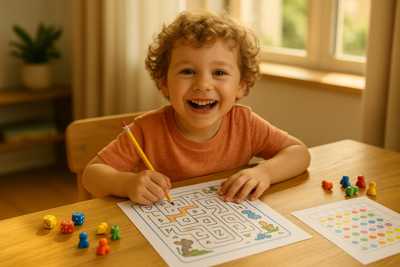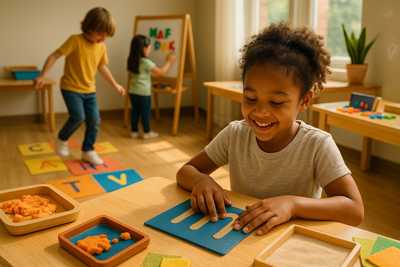Creating a Calm Learning Space at Home - A Parent's Guide to Better Focus
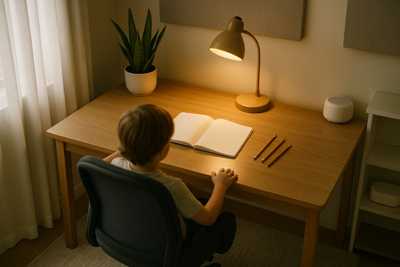
Image made with AI (DALL-E)
Discover how lighting, sound, temperature, and texture impact your child's focus. Simple, science-backed home adjustments for a distraction-free study space that actually works.
Why Your Kitchen Table Isn't Cutting It (And What Science Says About It)
Look, I get it. You thought setting up a home learning space meant clearing a corner of the dining table and calling it a day. Maybe tossing in a pencil holder for good measure. Chef's kiss. Done, right?
Except your kid is still staring at the wall like it's showing a Netflix series only they can see. The homework that should take twenty minutes somehow stretches into an Olympic endurance event. And you're starting to wonder if you're raising a future philosopher or just someone who's really good at avoiding math.
Here's the thing: your child's environment isn't just their backdrop—it's actively working with or against their brain. Educational psychologist Dr. Angus Gellatly points out that environmental distractions literally consume working memory resources. Translation? That pile of unfolded laundry in their sightline is stealing brain power from their multiplication tables. Rude, right?
The good news? You don't need an interior designer or a second mortgage to create a calm learning space at home that actually supports focus. You just need to understand how lighting, sound, texture, and temperature affect concentration—and make a few strategic tweaks. Let's turn that chaotic corner into a proper home study environment for kids.
The Science Behind Why Space Matters (Promise This Won't Be Boring)
Before we dive into the how-to, let's talk about the why for a second. Because understanding this makes you dangerous—in a good way.
Your child's brain is basically trying to run high-performance software (learning algebra, remembering state capitals, understanding why the mitochondria is the powerhouse of the cell). But if the hardware (their environment) is glitchy? The whole system slows down.
Research from the University of Salford found that tweaking environmental factors—like adding plants or adjusting lighting—improved focus scores by 15% while reducing stress markers. That's not trivial. That's the difference between homework battle royale and "huh, that wasn't so bad."
Interior design specialists have also discovered that visual clutter creates something called decision fatigue. Basically, every poster, toy, and random knickknack in view is quietly asking your kid's brain to make micro-decisions: "Should I look at that? What is that? Do I need that?" Within 15-20 minutes, their mental energy tank is running on fumes.
The environmental factors that affect student concentration aren't mysterious. They're measurable, fixable, and honestly? Kind of fascinating once you start noticing them.
Lighting: The Unsung Hero of Homework Success
Why Your Overhead Fluorescent Is Sabotaging Everything
Let's talk about the best lighting for children's study area, because this is where most of us get it spectacularly wrong.
That harsh overhead light? The one that makes everyone look slightly undead? Yeah, that's not helping. And if your kid is squinting at a screen while the sun sets behind them, creating a glare that could signal passing aircraft—also not ideal.
How lighting affects student focus and concentration comes down to a few key factors:
- Color temperature matters: Warm-toned light (2700-3000K) reduces eye strain and creates a calm atmosphere. Cool, blue-toned light works during daytime but actively disrupts circadian rhythms during evening study sessions—basically telling your kid's brain it's noon when it's actually 7 PM.
- Intensity counts: You want task lighting at 300-500 lux on the actual work surface. Not so bright they're squinting, not so dim they're leaning into the page like they're reading ancient scrolls.
- Natural lighting for student concentration wins every time when available—position desks near windows, but avoid direct glare on screens.
The Lighting Setup That Actually Works
Here's your action plan for creating the best lighting setup:
- Install dimmable LED bulbs in warm tones (2700-3000K). Yes, they cost more upfront. Yes, they're worth it.
- Position a desk lamp about 15 inches from the work surface, angled to avoid screen glare.
- Layer your lighting: bright task light for reading and writing, softer ambient light for the rest of the room.
- Use blue light filters on devices during evening homework sessions—most devices have this built-in now (check settings for "Night Shift" or "Night Light").
Pro tip: If your budget is tighter than your kid's attention span before lunch, start with just one good desk lamp. It'll make more difference than repainting the walls or buying fancy furniture.
Sound Management: Finding Your Family's Focus Frequency
The Goldilocks Zone of Background Noise
Can we talk about sound management for home schooling? Because this one's tricky.
Some kids need library-level silence. Others actually focus better with gentle background noise. The trick is figuring out which type of learner you're working with—and then optimizing for that.
The research is pretty clear: background noise above 70 decibels (roughly conversation level) measurably tanks academic performance. But moderate white noise between 50-60 dB? That actually helps some learners by masking variable, unpredictable sounds.
Think of it this way: your brain can tune out consistent sound (a fan humming). It can't ignore random sound (a dog barking, a sibling yelling, a garbage truck backing up while playing its greatest hits).
How to Soundproof a Child's Study Room (Without Breaking the Bank)
These are low-cost ways to reduce noise in home study areas:
- Add soft materials: Rugs, curtains, upholstered furniture, wall tapestries—these absorb sound instead of bouncing it around like a racquetball court.
- Position strategically: Place the desk away from doors, HVAC vents, and shared walls with the kitchen or TV room.
- Use acoustic panels: You can get affordable foam panels that actually work. Bonus: let your kid pick the colors so they feel ownership.
- Test white noise options: Try a fan, white noise machine, or apps with brown noise, pink noise, or nature sounds. Give each option a week-long trial and ask your kid which felt best.
The goal isn't creating a sensory deprivation chamber. It's reducing distractions from the home learning space so your kid's brain isn't constantly on alert for the next random sound.
Temperature and Air Quality: The Invisible Performance Killers
This might sound picky, but hear me out: the optimal study room temperature for focus sits between 68-72°F (20-22°C).
Below 65°F? Focus drops by about 20% because the body's busy trying to warm itself up. Above 75°F? Mental fatigue increases as thermoregulation kicks in. Your kid isn't being dramatic when they say they "can't think" in a stuffy room—they literally can't, at least not as well.
Air quality matters too. When CO2 levels climb above 1000 ppm (which happens faster than you'd think in small, closed spaces), decision-making and cognitive performance decline. Open a window occasionally, run an air purifier, or add some plants. Speaking of which...
The Houseplant Hack Nobody Talks About
That 2023 University of Salford study found that adding plants to study spaces improved focus scores by 15% while cutting stress markers. Plants quietly improve air quality, add natural visual interest without being distracting, and trigger something in our lizard brains that says "this is a good place to be."
You don't need a jungle. One pothos or snake plant will do. Bonus: they're nearly impossible to kill, which is ideal for busy parents who sometimes forget they have plants. (Just me? Cool, cool.)
Creating a Sensory-Friendly Study Environment: Texture, Comfort, and the Tools That Help
Why Texture Matters More Than You Think
When thinking about texture and comfort in learning spaces, we're really talking about tactile input and sensory processing. Some kids (especially those with ADHD or sensory processing differences) need fidget-friendly materials and varied textures to maintain focus.
Here's what this looks like in practice:
- Seating options: A chair with proper lumbar support is baseline. But consider adding a cushion, wobble stool, or under-desk footrest for kinesthetic learners who focus better when moving slightly.
- Soft surfaces: Rugs, cushions, and fabric items reduce harsh sound reflections and provide sensory comfort.
- Fidget tools: Small, quiet fidgets (stress balls, textured bands, putty) can actually help some learners by giving restless hands something to do so the brain can focus.
The key is matching environmental features to your specific child's sensory profile, not just copying some Pinterest board titled "Perfect Study Room 2024."
How to Design a Home Learning Room for ADHD Students (and Everyone Else, Really)
Kids with ADHD benefit from the same environmental factors as neurotypical kids—just more so. The strategies that help ADHD learners tend to help all learners, honestly.
When creating a distraction-free study zone at home:
- Visual simplicity wins: Keep the 15-foot sightline clear of toys, posters, and busy patterns. Store supplies in labeled, opaque containers so they're accessible but not visually screaming for attention.
- Spatial consistency matters: Using the same spot daily helps the brain associate that space with "learning mode." It's behavioral conditioning, but like, the helpful kind.
- Movement breaks are features, not bugs: Build in scheduled 5-minute movement breaks every 20-30 minutes. This isn't a reward for finishing work—it's part of the work process.
Reality check: Remote-learning families who implemented a dedicated "calm corner" with consistent lighting and minimal visual distractions reported a 40% improvement in homework completion rates. That's not magic—it's environmental psychology in action.
Step-by-Step: Setting Up Your Calm Learning Space
Alright, enough theory. Here's your actual, implementable game plan for the best way to set up a home learning space for elementary kids (and older ones too).
Step 1: Audit Your Current Situation
Before changing anything, gather baseline data:
- Take photos of the study area in daylight and evening
- Measure ambient noise with a free smartphone app (search "decibel meter")
- Note temperature fluctuations throughout the day
- Track how long your kid can focus before zoning out (average it over a week)
This isn't busywork—you need a before picture to know if your changes actually help.
Step 2: Fix the Lighting First
This gives you the biggest bang for your buck:
- Install dimmable warm LED bulbs (2700-3000K)
- Position a desk lamp 15 inches from the work surface, angled away from screens
- If possible, orient the desk to get natural light without direct glare
- Add blackout curtains or shades for afternoon sun control
Step 3: Address Sound and Acoustics
Layer in noise management:
- Add one soft element at a time (rug, then curtains, then upholstered furniture) and test noise levels between each addition
- Reposition the desk away from high-traffic areas and noise sources
- Try different background sound options (silence, white noise, brown noise, nature sounds) for a week each
- Track which option correlates with better focus
Step 4: Declutter Strategically
This might hurt, but it's necessary:
- Remove everything from the desk that isn't actively being used for current work
- Clear the 15-foot sightline of visual distractions
- Store supplies nearby but out of sight (labeled bins, desk drawers, closet organizers)
- Keep one personal item (photo, small plant, favorite rock) for emotional connection without overwhelm
Step 5: Optimize Temperature and Air
Make the invisible stuff work for you:
- Set the thermostat to 68-72°F during study times
- Add a small desk fan if needed for air circulation
- Open windows periodically to refresh air quality
- Consider adding a small plant (pothos, snake plant, spider plant) for passive air improvement
Step 6: Add Sensory Supports As Needed
Customize based on your specific kid:
- Provide fidget tools for kinesthetic learners (but keep them quiet—no clicky pens!)
- Ensure the chair provides proper support (feet flat on floor or footrest, back supported)
- Add a weighted lap pad if deep pressure helps your child regulate
- Test and adjust based on feedback—this isn't one-size-fits-all
Step 7: Test, Track, and Iterate
Here's where you become a scientist:
- Track focus duration weekly (how long before the first distraction?)
- Change one variable at a time (lighting, then sound, then temperature) so you know what's actually making a difference
- Ask your kid for feedback—they're the user of this space, after all
- Adjust based on what the data (and your kid) tells you
FAQ: Your Burning Questions About Home Study Environments
What environmental factors affect student concentration most?
The big four are lighting, sound, temperature, and visual clutter. But here's the thing—they're interconnected. Poor lighting makes kids squint and strain, which causes fatigue, which makes them more sensitive to sound and temperature fluctuations. Fix the foundational issues (light and sound) first, then fine-tune from there.
How does room temperature really affect learning ability?
More than you'd think, actually. Cognitive performance peaks at 68-72°F. Drop below 65°F and focus decreases by about 20% as the body diverts energy to staying warm. Crank it above 75°F and mental fatigue increases because thermoregulation is hard work. Your kid's complaints about being too hot or cold aren't stalling tactics (well, not always)—they're legitimate barriers to focus.
Should I use white noise machines or complete silence?
It depends on your specific learner. Some kids—particularly those with sensory sensitivities—need near-silence (below 50 dB, quiet library level). Others focus better with gentle white or brown noise at 50-60 dB because it masks unpredictable background sounds. The only way to know is to test both approaches for at least a week each and see which correlates with better focus and homework completion.
How can parents create a distraction-free study space on a budget?
Start with the high-impact, low-cost changes: one good desk lamp ($20-40), blackout curtains if you need light control ($25-50), and a rug or soft furnishings you might already own. Decluttering is free and makes a huge difference. Skip the expensive furniture upgrades until you've optimized light, sound, and visual simplicity—those matter way more than a fancy desk.
How often should I redesign the study space?
Don't. Well, not completely. Maintain the core structure—lighting setup, acoustic treatments, furniture placement, and sensory supports—consistently. Your kid's brain needs to associate this space with learning, which requires repetition. That said, you can rotate small visual elements (swap out posters seasonally, change which plant you use, update bulletin board content) to prevent habituation without destabilizing the core environment. Think evolution, not revolution.
The Bottom Line: Your Home Learning Lab
Here's what nobody tells you about creating a calm learning space at home: it's not a one-and-done decorating project. It's an ongoing experiment where you're testing variables, tracking results, and optimizing based on what works for your specific kid.
The best practices for organizing a calm study space aren't mysterious or expensive. They're grounded in environmental psychology and learning science. And yeah, they require some upfront effort. But so does yelling "Focus!" seventeen times during homework. At least this approach actually works.
Your action items:
- Start with lighting—it's the highest-impact change
- Add sound management next (soft materials, strategic positioning, maybe white noise)
- Declutter ruthlessly, but leave one personal connection item
- Test temperature and air quality adjustments
- Track what actually improves focus (trust data, not Pinterest)
The goal isn't perfection. It's creating a sensory-friendly study environment setup that works with your kid's brain instead of against it.
Now go forth and optimize. Your future self—the one not negotiating with a distracted kid for the forty-third time this week—will thank you.
Links marked with an asterisk (*) are affiliate links to external offers. If you click on such a link and make a purchase through it, we receive a commission from the provider. The price does not change for you.
Related Articles

From Frustration to Fun - Turning Writing Practice Into Play
Discover game-based writing exercises that transform reluctant writers into eage...
9 min read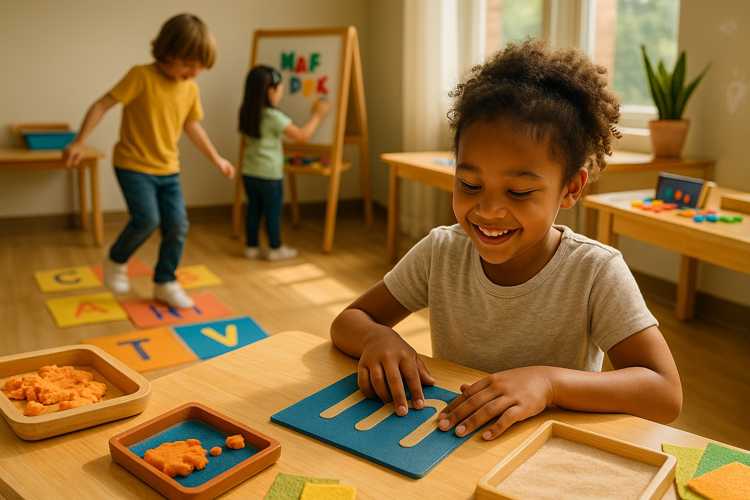
Building Reading Confidence Through Multisensory Activities That Actually Work
Discover research-backed hands-on reading techniques using touch, sound, and mov...
10 min read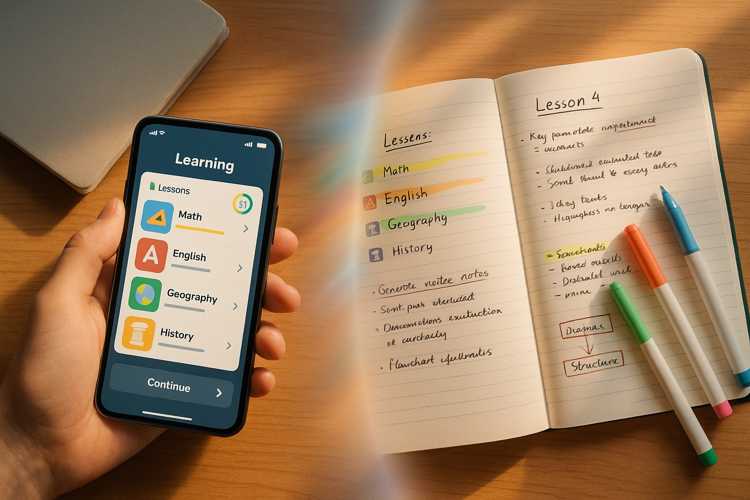
Bridging Apps and Offline Learning - Making Tech Work for You
Discover how combining educational apps with physical workbooks boosts retention...
8 min read
Why Consistency Beats Complexity in Teaching Basic Skills (Especially for Neurodivergent Learners)
Discover how structured repetition and daily routines help neurodivergent learne...
11 min read